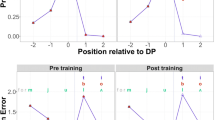Abstract
This is the second part of a project aimed at establishing the role of lateral inhibition in spreading-activation models of language production. While the first part (Berg & Schade, 1992) reviewed the psycholinguistic evidence for inhibition and established that indeed inhibition takes place, this paper addresses the issue from the implementational perspective. A series of computer simulations are reported in which spreading-activation models with or without inhibition are directly contrasted. The performance of the competing models is evaluated against two sets of criteria. On the more technical side, the “heat death” and the selection problems have to be solved. That is, the target must have a high and the nontarget units a low level of activation. Additionally, there are certain empirical effects from the production literature which may serve as test cases for deciding between the rival models. The results of the simulations indicate that only the inhibition-based model proves capable of meeting all challenges. All inhibitionless variants fail in one or more respects. It is further shown that the need for the inhibitory component increases with the size of the processing network and that one well-known production model can do without lateral inhibition only at the expense of introducing a concept which resembles inhibition in its effect but cannot replace it.
Similar content being viewed by others
References
Berg, T. (1987). The case against accommodation: Evidence from German speech error data.Journal of Memory and Language, 26, 277–299.
Berg, T. (1988).Die Abbildung des Sprachproduktionsprozesses in einem Aktivationsflußmodell. Tübingen: Niemeyer.
Berg, T., & Schade, U. (1992). The role of inhibition in a spreading-activation model of language production. I. The psycholinguistic perspective.Journal of Psycholinguistic Research, 21, 405–434.
Dell, G. S. (1985). Positive feedback in hierarchical connectionist models: Applications to language production.Cognitive Science, 9, 3–23.
Dell, G. S. (1986). A speading-activation theory of retrieval in sentence production.Psychological Review, 93, 283–321.
Dell, G. S. (1988). The retrieval of phonological forms in production: Tests of predictions from a connectionist model.Journal of Memory and Language, 27, 124–142.
Dell, G. S., & Reich, P. A. (1981). Stages in sentence production: An analysis of speech error data.Journal of Verbal Learning and Verbal Behavior, 20, 611–629.
Del Viso, S., Igoa, J. M., & García-Albea, J. E. (1991). On the autonomy of phonological encoding: Evidence from slips of the tongue in Spanish.Journal of Psycholinguistic Research, 20, 161–185.
Eikmeyer, H.-J. (1987).CheOPS: An object-oriented programming environment in CPROLOG (Tech. Rep. “Kolibri” 4). Bielefeld, Germany: Bielefeld University.
Eikmeyer, H.-J., & Schade, U. (1991). Sequentialization in connectionist language-production models.Cognitive Systems, 3, 128–138.
Feldman, J. A., & Ballard, D. H. (1982). Connectionist models and their properties.Cognitive Science, 6, 205–254.
Garnham, A., Shillock, R. C., Brown, G. D. A., Mill, A. I. D., & Cutler, A. (1981). Slips of the tongue in the London-Lund corpus of spontaneous conversations. In A. Cutler (Ed.) Slips of the tongue and language production, special issue ofLinguistics, 19, 7/8, 805–817.
Hinton, G. E. (1991). Mapping part-whole hierarchies into connectionist networks. In G. E. Hinton (Ed.),Connectionist Symbol Processing (pp. 47–75). Cambridge, MA: MIT Press.
Johnson-Laird, P. N. (1988).The Computer and the Mind. London: Fontana.
Levitt, A. G., & Healy, A. F. (1985). The roles of phoneme frequency, similarity, and availability in the experimental elicitation of speech errors.Journal of Memory and Language, 24, 717–733.
MacKay, D. G. (1987).The Organization of Perception and Action. New York: Springer.
McClelland, J. L., & Elman, J. L. (1986). The TRACE model of speech perception.Cognitive Psychology, 18, 1–86.
McClelland, J. L. & Rumelhart, D. E. (1981). An interactive activation model of context effects in letter perception. Part 1: An account of basic findings.Psychological Review, 88, 375–407.
Meyer, A. S. (1991). The time course of phonological encoding in language production: Phonological encoding inside a syllable.Journal of Memory and Language, 30, 69–89.
Rumelhart, D. E., & McClelland, J. L. (1982). An interactive activation model of context effects in letter perception. Part 2: The contextual enhancement effect and some tests and extensions of the model.Psychological Review, 89, 60–94.
Rumelhart, D. E., & McClelland, J. L. (1986).Parallel Distributed Processing: Explorations in the Microstructure of Cognition, Vol. 1: Foundations. Cambridge, MA: MIT Press.
Schade, U. (1992).Konnektionismus-Zur Modellierung der Sprachproduktion. Opladen, Germany: Westdeutscher Verlag.
Shattuck-Hufnagel, S. (1987). The role of word-onset consonants in speech production planning: New evidence from speech error patterns. In E. Keller & M. Gopnik (Eds.),Motor and Sensory Processes of Language (pp. 17–51). Hillsdale, NJ: Erlbaum.
Stemberger, J. P. (1985a). An interactive activation model of language production. In A. W. Ellis (Ed.),Progress in the Psychology of Language (Vol. 1, pp. 143–186). London: Erlbaum.
Stemberger, J. P. (1985b).The Lexicon in a Model of Language Production. New York: Garland.
Waltz, D. L., & Pollack, J. (1985). Massively parallel parsing: A strongly interactive model of natural language interpretation.Cognitive Science, 9, 51–74.
Author information
Authors and Affiliations
Additional information
We acknowledge, with gratitude, Gary Dell's comments on the manuscript.
Rights and permissions
About this article
Cite this article
Schade, U., Berg, T. The role of inhibition in a spreading-activation model of language production. II. The simulational perspective. J Psycholinguist Res 21, 435–462 (1992). https://doi.org/10.1007/BF01067523
Accepted:
Issue Date:
DOI: https://doi.org/10.1007/BF01067523




